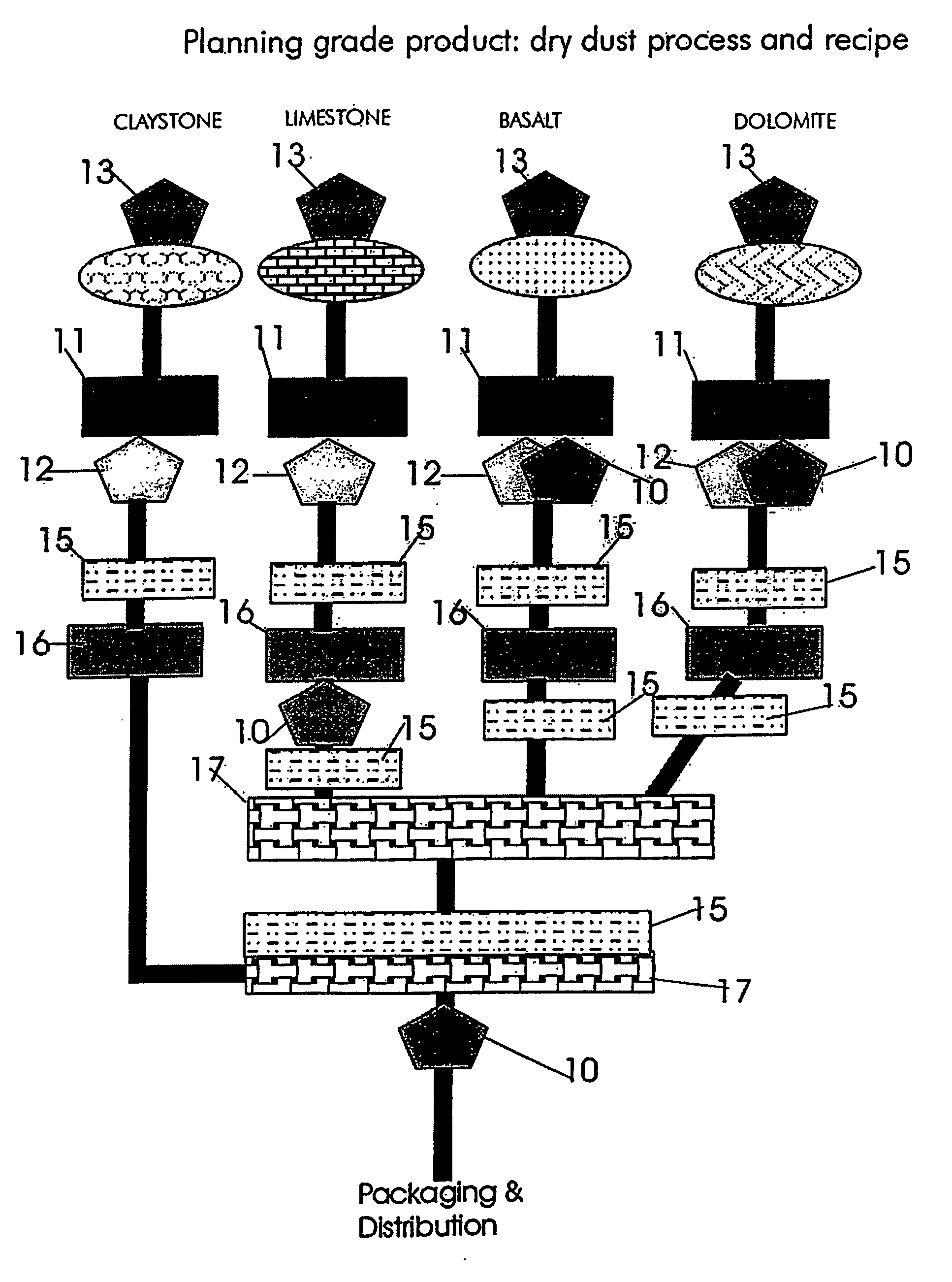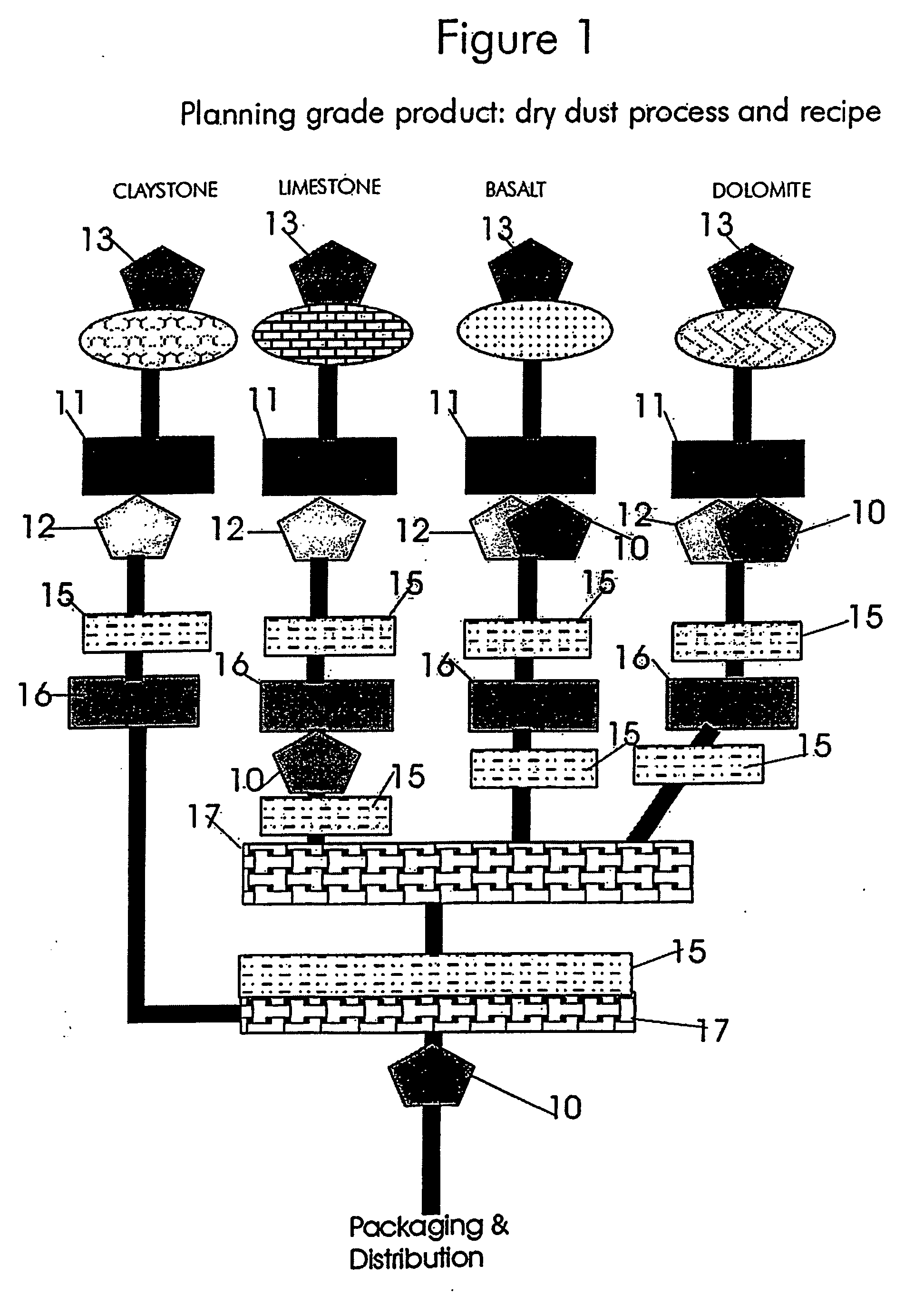Soil additive
a technology of soil additive and organic fertilizer, applied in the field of soil treatment, can solve the problems of increasing concentration, physical reduction of soil depth and mass, and locking land managers into an unsustainable cycle of synthetic fertilizer application, and achieve the effect of convenient commercial choi
- Summary
- Abstract
- Description
- Claims
- Application Information
AI Technical Summary
Benefits of technology
Problems solved by technology
Method used
Image
Examples
first embodiment
[0107] In a first embodiment, the final product is produced according to the production flowsheet given in FIG. 1 and is the planning grade product described above. The overall process may be explained by analysing the series of subsidiary processes involved.
[0108] The source rocks undergo analysis 13 to determine the mineralogical, physical and textural suitability for use in the invention. This analysis 13 involves, identifying a series of mineralogical and textural characteristics highly desired in source rocks to be used in the invention. The preferred individual source rocks and their desired attributes to complete analysis 13 are individually defined immediately below:
[0109] BASALT: Basalt, in this instance, refers to aphanitic, basic, mafic, igneous rock. Basalts are low Si rocks, with SiO2 generally below 53%, with a range of compositional variations particularly in relation to Mg and Fe ratios and alkali contents. The primary method for determination of suitability of a pa...
second embodiment
[0143] the final product is produced according to the production flowsheet given in FIG. 2 and is the management grade product described above. The overall process may be explained by analysing the series of subsidiary processes involved.
[0144] The source rocks undergo analysis 13 to determine the mineralogical, physical and textural suitability for use in the invention. This analysis 13 involves, identifying a series of mineralogical and textural characteristics highly desired in source rocks to be used in the invention. The preferred individual source rocks and their desired attributes to complete analysis 13 are individually defined above in the analysis 13 for the planning grade product and remain the same for the management and shock grade product lines.
[0145] The next step is crushing 11 the source rocks to a particular size fraction. In this embodiment, the size fraction required at this stage is at or below 20 mm. The crushing 11 may preferably be performed under dry condi...
third embodiment
[0157] the final product is produced according to the production flowsheet given in FIG. 3 and is the Shock grade product described above. The overall process may be explained by analysing the series of subsidiary processes involved.
[0158] The source rocks undergo analysis to determine the mineralogical, physical and textural suitability for use in the invention. This analysis 13 involves, identifying a series of mineralogical and textural characteristics highly desired in source rocks to be used in the invention. The preferred individual source rocks and their desired attributes to complete analysis 13 are individually defined above in the analysis 13 for the planning grade product and remain the same for the management and shock grade product lines.
[0159] The next step is crushing 11 the source rocks to a particular size fraction. In this embodiment, the size fraction required at this stage is at or below 20 mm. The crushing 11 may preferably be performed under dry conditions bu...
PUM
| Property | Measurement | Unit |
|---|---|---|
| size fraction | aaaaa | aaaaa |
| size | aaaaa | aaaaa |
| size fraction | aaaaa | aaaaa |
Abstract
Description
Claims
Application Information
 Login to View More
Login to View More - R&D
- Intellectual Property
- Life Sciences
- Materials
- Tech Scout
- Unparalleled Data Quality
- Higher Quality Content
- 60% Fewer Hallucinations
Browse by: Latest US Patents, China's latest patents, Technical Efficacy Thesaurus, Application Domain, Technology Topic, Popular Technical Reports.
© 2025 PatSnap. All rights reserved.Legal|Privacy policy|Modern Slavery Act Transparency Statement|Sitemap|About US| Contact US: help@patsnap.com



